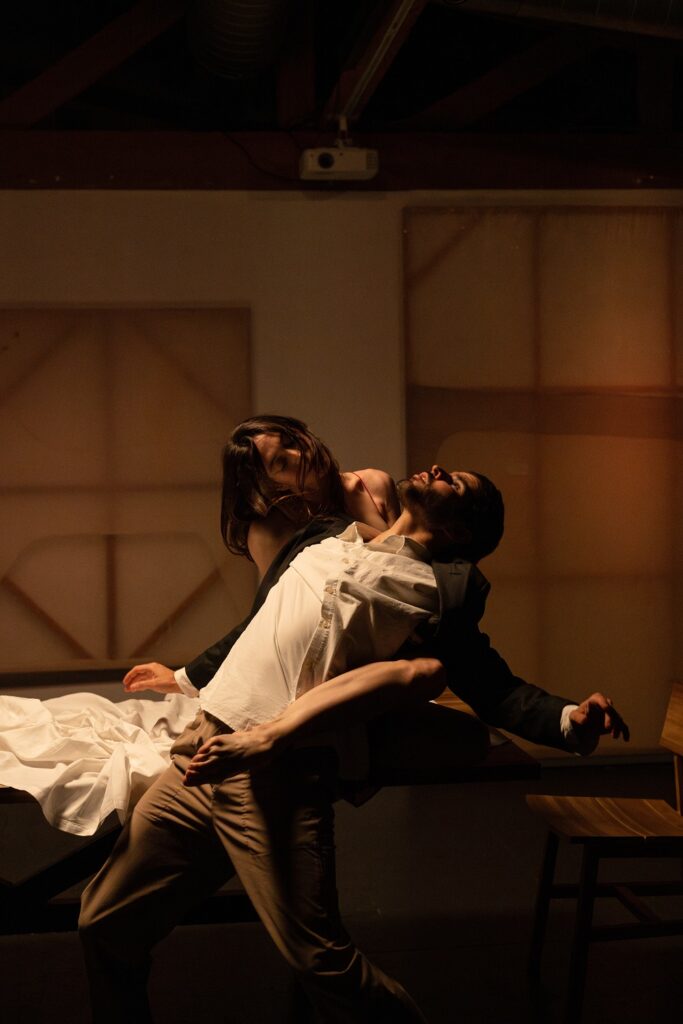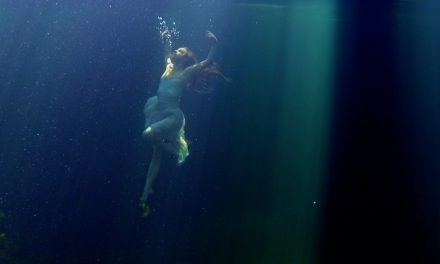Megan Paradowski, choreographer and creator of movement company Empara, hosted a two hour immersive experience at Melody Wine Bar this past Monday night for an unprecedented evening of dining and dancing. The menu, by chef Sera Domenica, was set in three courses directly corresponding to the atmosphere and theme by dancers Daphne Fernberger, Marco Palomino, Shauna Davis, and Travis Lim. And as intriguing as the phrase “immersive experience” is to try, by both theater goers and thrill seekers alike, it is often difficult to unfold the idea into a physical reality. Empara’s Well Done suddenly opened how art could be made here in LA and gave us an insight to the natural unfoldings of invitation without the anxiety of being included.
Well Done was smart with its audience. They did not come in hard and fast for shock and awe…the performers took their time. In fact, Fernberger even pretended to be an audience member and diner, for nearly a full thirty minutes before moving amongst the crowd. The welcome was engaging and unforced, natural and unpredictable. Diners and onlookers were met with a drink, beautiful spring snacks of cheese, breads, fresh cherries, and enticing whipped spreads. While strangers engaged with one another in the sun filled outdoor space, Lim remained in a back corner of the restaurant moving in and out of solo tableaus. It felt as though he wanted the attention of onlookers, and yet did not want the attention at all. Lim would subtly engage with the mingling audience as he moved through the space, and it almost felt like we were the performance instead of the other way around. When Fernberger climbed on top of a long wooden dining room table in the outside courtyard we knew Well Done had officially started. In slow spatial movements, she glided across the surface in black velvet and mesh pants, never engaging with the audience the way Lim did. She was engrossed in her own bubble, her own world, like the loneliest woman in a crowd diving deeper into herself. Both Lim and Fernberger mimicked the types of experiences a person has dining out; that divine extroverted introverted magic that is a true LA virtue.
With cohesive and flawless production by Halston Bruce, the servers and movers weaved around the small corners and corridors effortlessly between movement moments. As the three course meals were served, the performers would consistently emerge into trios or off shoot into duets throughout the space. In one engaging sequence, dancers Palomino and Davis sat at opposite ends of a dining table in the outdoor courtyard dipping their fingertips into water glasses but never using the full extent of their hands to eat a plate of grapes in front of them. Watching this duet felt like you were watching fellow restaurant goers engaging in a dinner that wanted to be a dance, like it was reaching the tipping point of unacceptable behavior in public. And in this fight for attention we received another remarkable moment where all four dancers engaged with one another in different duets around the restaurant. And since Melody Wine Bar is a converted bungalow house, we see moments between Fernberger and Palomino on the stairway in a seeming relationship full of jealousy and turmoil as body parts are pushed, and weight is shared.
Perhaps it is due to the intimacy of the wine bar, and perhaps it is due to the execution of movement, but you got this feeling that you were always seeing something you weren’t supposed to see. Taking a bite of food, you would converse with a friend at the table, catch a dancer in the corner of your eye, break away from an embrace, arms extended, chasing after one another, and you will never know what truly happened beforehand because you did not see. It was easy to take the small narrative you did witness however, and run with your own storyline, like an immersive game of telephone. While the movers of Empara often improvised based on the atmosphere of where the audience members were seated, a good number of the choreography was synced and set to a particular site within the restaurant. A favorite being any number that took place beyond the front window where not only diners could see but onlookers from the street who happened upon this performance could stop and enjoy without context. The choreography often suggested a taunting and flirtatious game of who controls whom, which was most evident in the finale of the show.
As a quartet, Davis, Fernberger, Palomino, and Lim would work together to create tableaus by partnering and climbing over one another to come up with a predetermined structure. Lighting Designer, Colin Lupe, intensified the neon blues and reds throughout the space to create a dramatic and emotional tension within the space, while the dancers did elusive touches on the thighs and shoulders of the crowd. In the final moments, Lim, Palomino, and Davis carried Fernberger above their shoulders in a slow walk from the back of the restaurant to the front, and you got that “wow, this is ending” feeling that gives you the sign you’re okay to release anything you are feeling. Empara presents Well Done as an engaging example of how to move dance into new spaces where so many would not be expecting performance at all. Its mysterious nature between mover and performer alludes to expansive and flexible shows that could be performed anywhere for anybody.
To learn more about Empara, please visit their website.
Written by Grace Courvoisier for LA Dance Chronicle.
Featured image: Daphne Fernberger and MarcoPalomino in “Well Done” – Photo by Teal Thomsen.











